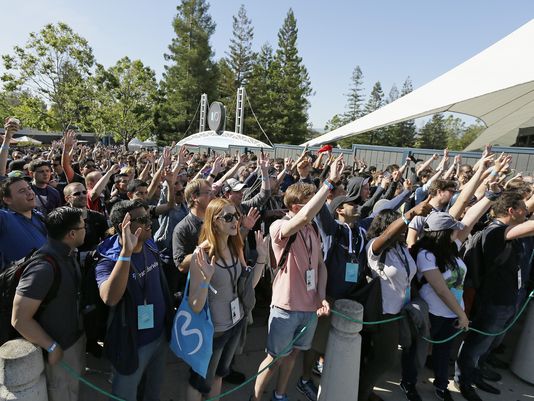The future of computing will be ambient and invisible

Bob O'Donnell, Special for USA TODAY 12:49 p.m. EDT May 18, 2016

People wave while waiting to take their seats to hear the keynote address of the Google I/O conference in Mountain View, Calif. (Photo: Eric Risberg, AP)
FOSTER CITY, Calif.—Computers as we know them are about to disappear.
Well, okay, they won’t completely disappear, but they will take on a new form that makes them very difficult to distinguish from everyday objects all around us.
This transformation is part of a bigger, longer term trend that some have dubbed “ambient” computing. The idea is that computing capability will end up being embedded in devices ranging from speakers to automobiles, and will provide capabilities and services to us throughout the day via the environment around us.
“The difference between receiving useful information or performing specific actions automatically, as opposed to instigating the efforts on our own, is profound”
Bob O'DonnellThe most obvious example of ambient computing to date is Amazon’s Echo line of products. Echo and Tap integrate the company’s Alexa digital assistant into what appears to be a Bluetooth speaker. Amazon’s Dot integrates only the microphone and works with existing Bluetooth speakers. While Echo got off to a bit of a slow start, it’s picked up a fair bit of steam recently and is now considered by many to be the darling of the tech world.
At Google I/O later this week, Alphabet (the parent company of Google) is expected to unveil its own ambient computing device [1]leveraging the Google Now personal assistant architecture. Many others have speculated that Apple will eventually launch a similar product, using its Siri personal assistant, and that Microsoft will turn its Cortana feature of Windows 10 into a more full-fledged ambient computing platform.
As interesting as these devices may prove to be, however, the most fascinating thing about ambient computing is that—in theory, at least— it can go well beyond these relatively simple audible search engines and command centers.
Leveraging all the sensor technology now being integrated into digital devices, for instance, ambient computing can (and eventually will) start to provide smarter, more “contextual” information.
If I walk outside, for example, or if I’m moving at a fast pace, the kind of information I receive from a request can and should be different than what I would receive if I’m at home. In fact, just the process of moving into a new environment should deliver new types of information or services even without a specific request.
While seemingly subtle, the difference between receiving useful information or performing specific actions automatically, as opposed to instigating the efforts on our own, is profound. It also represents an important new phase in the usefulness and value of our “intelligent” devices.
In that way, ambient computing should be able to deliver on the potential of contextual computing or contextual intelligence: giving me the information or services I need at precisely the time I need them, without even asking. It also offers a significant improvement in the overall ease-of-use of these devices and makes them potentially accessible and usable by virtually anyone in the world.
Most early ideas around ambient computing are focused on non-traditional computing devices, but there’s also no reason we won’t see ambient-style computing being integrated into smartphones and other more traditional “intelligent” devices, as well.
Smartphones, in particular, incorporate all the elements necessary to deliver a very thorough and very beneficial ambient experience. Built-in speakers, microphones, sensors, network connections and raw compute power, combined with the right kind of software and services could turn smartphones into even more useful devices—even when, or particularly when, we’re not staring at their screens.
Other implications related to ambient computing developments could have a much more disruptive impact on the technology industry as we currently know it. For one, ambient computing typically relies on voice or other non-traditional methods of input and interaction. That, in turn, implies much less dependence on the traditional app and platform model. In fact, as the Echo has proven, it’s entirely possible to do useful computing without a screen of any kind.
With ambient computing, simply speaking at (or with) an intelligent device should trigger the appropriate actions, without having to worrying about downloading apps, platform compatibility, or other common issues. Of course, underneath the hood, because of the way they’re each built and the software they each employ, different devices are likely to respond differently to similar requests, just as different people will respond differently to the same question.
Nevertheless, the current OS platform wars and other technology-specific battles will likely fade away in the new world of ambient computing.
The idea of computing devices being all around us and reacting autonomously may be disconcerting or even frightening to some, but the range of possibilities that ambient computing enables also makes it an exciting opportunity for the future.
USA TODAY columnist Bob O'Donnell is the president and chief analyst of TECHnalysis Research, a market research and consulting firm that provides strategic consulting and market research services to the technology industry and professional financial community. His clients are major technology firms including Microsoft, HP, Dell, and Qualcomm. You can follow him on Twitter @bobodtech.[2]
Read or Share this story: http://usat.ly/27A2Dv5
References
- ^ is expected to unveil its own ambient computing device (http)
- ^ TECHnalysis Research (www.technalysisresearch.com)









